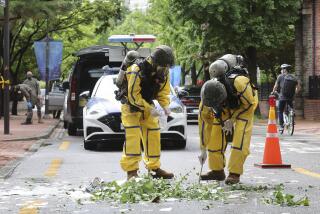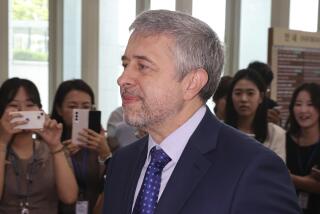South Korea pays for vast U.S. Army base expansion, but Trump wants it to pay more
Reporting from CAMP HUMPHREYS, South Korea — The new golf course and clubhouse will open next month. Along MacArthur Circle, 23 stone-clad villas reserved for American generals are finished, as are five apartment towers for military families.
Over by an airfield that buzzes day and night with Black Hawk and Chinook helicopters stands the imposing glass-and-brick headquarters for U.S. Forces Korea — the four-star command that transferred here in June from Seoul, an hour’s drive north.
Construction is finished on the grenade launcher range, the tank driving course and 41 barracks buildings. The new combat hospital is supposed to be ready by December. And if war breaks out with North Korea, there’s a rail depot to rush armored vehicles into the fight.
The U.S. military isn’t drawing down at this sprawling 3,600-acre Army base, as President Trump sometimes seems to favor. It’s building up, creating one of the Pentagon’s largest and most modern overseas facilities.
A decade-long construction blitz — mostly paid for by South Korea — has turned a sleepy airfield into a gated mini-metropolis for U.S. troops, dependents and contractors who were once scattered at multiple bases in Seoul and near the demilitarized zone dividing the Korean peninsula.
“We have created a new city, the newest, most modern facility in the United States Army,” said Paul Stuart, the deputy to the garrison commander at the base. “And we’re not done yet.”
But there is pervasive uncertainty about the future of the U.S. military here owing to Trump’s seemingly unshakable distaste for basing troops in any host country that, in his reckoning, fails to pay enough for what he calls American protection.
He has regularly put longtime ally South Korea in that group. Although Trump has said a pullout or drawdown of the 28,500 U.S. troops here is not on the table in his stalled nuclear negotiations with North Korea, the White House has pressured Seoul to pay considerably more.
That’s left even senior American officers unsure whether withdrawals might be coming if South Korea does not comply.
“We’re here and we feel like we’re going to be here for quite a while unless we hear otherwise,” said a senior U.S. officer, who asked not to be identified to speak candidly about such a sensitive subject. “We’ll see.”
White House officials recently floated a proposal called “cost plus 50,” under which some allies would be asked to pay the full cost of U.S. troops on their territory, along with another 50%. After the idea was leaked, acting Defense Secretary Patrick Shanahan told Congress it would not be implemented.
South Korean officials and Korea experts in the United States point out that Seoul already pays more than $900 million a year. That’s at least 50% of the cost of the U.S. military presence and more than almost any other U.S. ally. South Korea also built and paid for almost the entire $10.7-billion expansion at Camp Humphreys.
Hoping to mollify Trump, Seoul also has stepped up its purchases of U.S.-made weapons, warplanes and other equipment, making it one of the top buyers of American military hardware.
The total military and civilian population at the base now stands at 33,000, nearly tripling since 2012. The crush of soldiers and the families is causing early-morning traffic backups at the gates and lines at the only gas station on post.
An additional 10,000 are expected within a few years, once three more apartment towers are completed.
Three headquarters buildings were occupied in the last year by the U.S. 2nd Infantry Division, U.S. 8th Army, and South Korean forces that overlook the base’s 8,124-foot runway.
Along with the military facilities, the base hosts a suburban-style mall with a Starbucks, a Taco Bell and a well-stocked post-exchange, 24-hour gyms, a bowling alley, two movie theaters, a community pool with a two-story waterslide and soon-to-open mini-mart with a second gas station.
Enrollment at the on-base high school topped 500 this year, the highest ever. There’s even a building to house the 8th Army band.
“The base is huge,” said Lt. Col. Junel Jeffrey of the 2nd Infantry Division. “It’s like being in America, but a really, really nice America.”
The facilities don’t differ substantially from those in recently expanded military bases in the United States — only in this case American taxpayers didn’t foot the bill.
“Those who complain about the cost of American troops overseas don’t realize that the same troops would be even more expensive if deployed in the United States. And of course, Washington would no longer receive compensation from our allies,” said Bruce Klingner, a former CIA analyst on Korea who now works at the Heritage Foundation, a conservative think tank in Washington.
Congress grew so worried about Trump’s threats against longtime allies that last year it approved a provision barring him from reducing troop levels in South Korea below 22,000 this year unless he certifies to lawmakers that it is in U.S. national security interests.
Separate from Seoul’s spending at Camp Humphreys, the two governments signed a new agreement in February obligating Seoul to pay $923 million in 2019 toward U.S. military costs, an 8% increase over last year.
The deal came together only after Trump administration officials backed down from demands for as much as a 50% increase. But negotiators could reach only a one-year agreement, instead of the usual five years. So talks on the next annual payment are likely to resume soon and are even more fraught.
Trump added to that anxiety this month when he permanently canceled large-scale joint military exercises, known as Key Resolve and Foal Eagle, that were held each spring for more than a decade and involved thousands of U.S. and South Korean forces.
The decision gave Pyongyang a long-sought concession only days after a summit in Hanoi between Trump and North Korean leader Kim Jong Un broke down without any progress toward a nuclear disarmament deal. Kim has long denounced the training exercises as provocative “war games.”
After his first summit with Kim, in June in Singapore, Trump abruptly suspended several annual exercises, citing the cost and the need to ease tensions with North Korea.
Located along the Anseong River outside the industrial city of Pyeongtaek, much of Camp Humphreys was rice paddies two decades ago.
Construction was supposed to be finished in 2008 but the completion date slipped repeatedly, partly because millions of tons of earth had to be trucked in to fill flood-prone bottomland.
The site has the military virtue of being well south of the heavily fortified DMZ, putting U.S. troops stationed there out of range of all but the longest-range North Korean artillery and rockets, Army officers say.
A few U.S. artillery units remain at Camp Casey, nearer to the DMZ, but other ground combat forces are now consolidated at Camp Humphreys.
Outside the base gates, the coming of the Americans has meant a windfall for civilian businesses. Bars, vape shops and American-themed restaurants line the narrow streets, along with real estate brokers who advertise their services to soldiers living off-post with storefront pictures of smiling blond-haired families in front of suburban-looking mini-mansions.
Under an agreement with South Korea, 60% of the personnel assigned to the post are supposed to live off-post in private housing, a measure aimed at benefiting the local economy.
Real estate ads on trains from Seoul to Pyeongtaek urge South Koreans to invest in property around the base, reassuring them that the income is ironclad because the Americans will be around for decades.
Not everyone seems so sure.
Gen. Robert Abrams, the top U.S. commander in South Korea, recently batted away rumors that the Pentagon might not send another armored brigade, with about 3,400 soldiers, when the brigade now at Camp Humphreys rotates back to the United States in the summer.
“It is baseless,” Abrams told the South Korean news agency Yonhap on March 13 about the rumors of a possible drawdown.
More stories from David S. Cloud »
More to Read
Get the L.A. Times Politics newsletter
Deeply reported insights into legislation, politics and policy from Sacramento, Washington and beyond. In your inbox three times per week.
You may occasionally receive promotional content from the Los Angeles Times.











